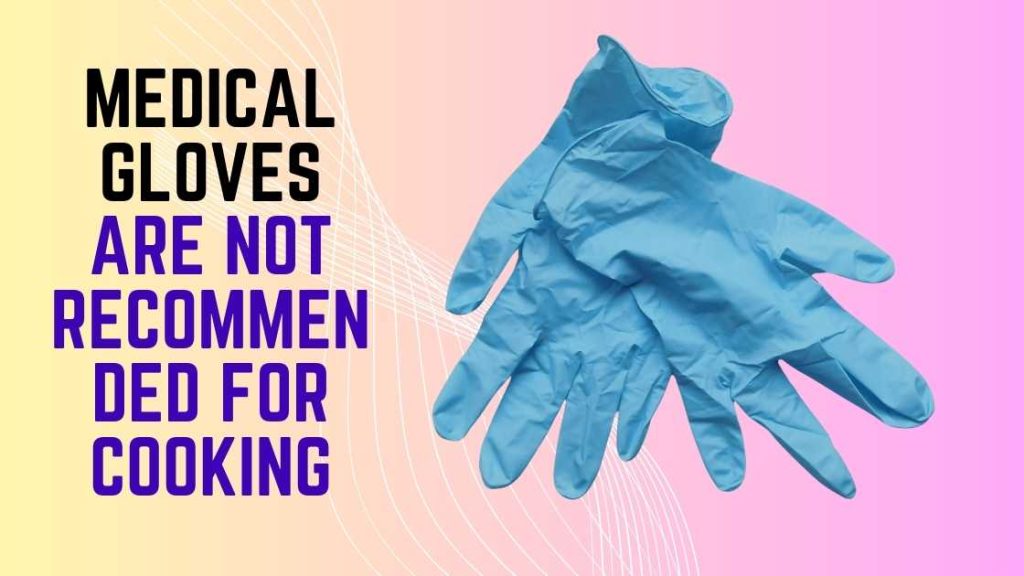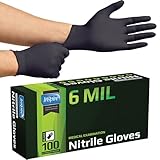No, medical gloves are not recommended for cooking. They are designed for medical and sanitary purposes and are not tested for food safety.
Medical gloves, typically made from latex, nitrile, or vinyl, are engineered to prevent contamination in medical environments. They offer protection against pathogens and chemicals but aren’t suitable for food contact. These gloves can sometimes contain powders, lubricants, or residues that might not be food-safe and could potentially contaminate the food. Also, they are not made to endure high temperatures, which can damage them and create safety risks when using them with hot foods or cooking tools.
Moreover, cooking gloves designed for culinary purposes are specifically crafted to handle high temperatures and are made from materials like silicone, which are safe for food contact and heat-resistant. Using appropriate kitchen gloves helps ensure both safety and hygiene, avoiding any health risks associated with the use of medical gloves in a culinary setting.

| Glove Type | Temperature Tolerance | Food Safe | Common Use | Notable Risk |
|---|---|---|---|---|
| Latex Gloves | Up to 70°C (158°F) | No | Medical, Laboratory | Powder residue can contaminate food |
| Nitrile Gloves | Up to 70°C (158°F) | No | Medical, Industrial | Chemical residues can affect food |
| Vinyl Gloves | Up to 50°C (122°F) | No | Medical, Household | Less resistant to heat; potential for chemical leaching |
When it comes to food safety, using gloves in the kitchen is essential. Gloves help prevent cross-contamination and protect both the food and the cook. While medical gloves may seem like a convenient option, it is important to know whether they are safe to use in a cooking environment.
The Difference between Medical Gloves and Food-Grade Gloves
Medical gloves and food-grade gloves are designed for different purposes and have specific characteristics tailored to their uses:
Medical Gloves
- Material: Typically made from latex, nitrile, or vinyl. Nitrile is often preferred for its resistance to punctures and chemicals.
- Standards: Must meet stringent standards set by organizations like the FDA (Food and Drug Administration) or ASTM (American Society for Testing and Materials). They are tested for sterility and barrier protection.
- Usage: Used in medical settings for procedures that require a high level of hygiene and protection from bodily fluids. They are also used to prevent cross-contamination between patients.
- Protection: Provide protection against bloodborne pathogens, chemicals, and biological contaminants.
Food-Grade Gloves
- Material: Often made from nitrile, vinyl, polyethylene, or latex. Polyethylene gloves are common in food preparation for their low cost and ease of use.
- Standards: Must comply with food safety regulations, such as those from the FDA, but the requirements are generally less stringent than for medical gloves. They need to be free from harmful chemicals and safe for contact with food.
- Usage: Used in food handling and preparation to maintain hygiene and prevent contamination. They are often used in restaurants, food processing, and food service.
- Protection: Provide a barrier between the food and the hands, preventing contamination and helping maintain food safety standards.
Key Differences
- Sterility: Medical gloves are often sterilized, whereas food-grade gloves may not be.
- Barrier Protection: Medical gloves offer a higher level of protection against biological hazards, while food-grade gloves are designed primarily for preventing food contamination.
- Regulations: Medical gloves are subject to stricter regulations due to their use in healthcare settings.
Why You Should Not Use Medical Gloves for Cooking
There are several reasons why you should not use medical gloves for cooking:
- Chemical Contamination: Medical gloves can contain chemicals that may be harmful if they come into contact with food. These gloves are not manufactured with food safety in mind, and their materials may not be suitable for direct food contact.
- Allergen Transfer: If you or anyone you’re cooking for has a latex allergy, using medical gloves can lead to allergen transfer. Latex gloves are commonly used in medical settings and can cause severe allergic reactions in sensitive individuals.
- Residue Transfer: Medical gloves are typically coated with powders, such as cornstarch or talcum powder, to facilitate easy donning. This powder can leave residue on food, affecting its taste and quality.
- Poor Grip: Medical gloves are not designed for handling food items. They may not offer the same level of grip as food-grade gloves, increasing the risk of slipping or dropping food.
Choosing the Right Gloves for Cooking
When choosing gloves for cooking, you’ll want to consider several factors to ensure safety, comfort, and efficiency. Here’s a guide to help you select the right gloves:
Types of Gloves
-
Food-Grade Disposable Gloves
- Material: Nitrile, vinyl, or polyethylene.
- Pros: Easy to use, disposable, and helps prevent cross-contamination.
- Best For: Handling raw meat, preparing food, and general kitchen tasks where frequent glove changes are needed.
- Considerations: Ensure they are food-safe and provide a good fit to avoid slipping.
-
Reusable Food-Safe Gloves
- Material: Rubber, silicone, or fabric with a food-safe coating.
- Pros: Durable, washable, and can be used multiple times. Often more comfortable for extended use.
- Best For: Tasks that require more dexterity or extended wear, like handling hot foods or working with heavy-duty tasks.
- Considerations: Ensure they are easy to clean and maintain, and check for any specific food safety certifications.
-
Heat-Resistant Gloves
- Material: Kevlar, silicone, or specialized heat-resistant fabrics.
- Pros: Protect hands from high temperatures, ideal for handling hot cookware or baking sheets.
- Best For: Cooking tasks that involve high heat, such as grilling or baking.
- Considerations: Look for gloves with a high heat resistance rating and good grip.
Choosing the Right Gloves
-
Fit and Comfort
- Gloves should fit snugly but not be too tight. Proper fit ensures dexterity and reduces the risk of accidents.
- For disposable gloves, check the sizing chart provided by the manufacturer.
-
Material
- Nitrile: Offers good puncture resistance and flexibility, suitable for most cooking tasks.
- Vinyl: Cost-effective and suitable for lighter tasks, though less durable.
- Polyethylene: Commonly used for single-use tasks and easy disposal.
- Silicone/Heat-Resistant: Ideal for high-temperature tasks, offering protection against burns.
-
Food Safety
- Ensure gloves are labeled as food-safe and meet relevant safety standards.
- Avoid using non-food-safe gloves, as they may contain chemicals or materials that could leach into food.
-
Ease of Use and Maintenance
- For disposable gloves, consider whether you need powdered or powder-free options.
- For reusable gloves, check if they are dishwasher-safe or require hand washing.
-
Grip and Dexterity
- Look for gloves with textured surfaces for better grip, especially when handling slippery or wet ingredients.
Proper Glove Usage and Disposal
When using gloves for cooking, it is important to follow these guidelines:
- Wash Hands: Before putting on gloves, thoroughly wash your hands with soap and water.
- Proper Donning: Put on gloves immediately before handling food to minimize contamination from other surfaces.
- Single-Use Only: Food-grade gloves should be used only once and then discarded. Reusing gloves can lead to cross-contamination.
- Glove Removal: Remove gloves carefully by peeling them off from the wrist to avoid contact with the outside surface.
- Hand Hygiene: After removing gloves, wash your hands with soap and water to further reduce the risk of contamination.
Additionally, make sure to dispose of used gloves properly in appropriate waste containers, following local regulations.
:max_bytes(150000):strip_icc()/best-dishwashing-gloves-according-to-an-expert-tout-71d5f091d68741618287a5866796bb79.jpg)
Credit: people.com
What types of medical gloves are safe for cooking?
For cooking, it’s best to use gloves that are labeled as food-safe. Nitrile and latex gloves are common types used in food handling because they are resistant to tearing and provide a good barrier against contaminants. Ensure that the gloves are specifically marked as safe for food handling to avoid any potential issues with harmful chemicals.
Are there any risks associated with using medical gloves for cooking?
The main risks of using medical gloves for cooking come from improper use or the wrong type of glove. Gloves that are not food-grade or are made from non-food-safe materials could contaminate your food. Additionally, gloves can tear or degrade if exposed to hot temperatures or sharp objects, so inspect them regularly for any signs of damage.
How should I use medical gloves properly when cooking?
- Clean Hands: Wash your hands thoroughly before putting on the gloves.
- Select the Right Gloves: Choose gloves labeled as food-safe, such as nitrile or latex.
- Check for Damage: Inspect the gloves for any tears or defects before use.
- Avoid Overuse: Change gloves frequently, especially if they become soiled or torn.
- Dispose Properly: Dispose of gloves properly after use and wash your hands again.
Can medical gloves be used for all types of cooking?
Medical gloves are suitable for most types of cooking, especially when you need to maintain hygiene or handle raw foods. However, they are not ideal for tasks involving high heat or sharp objects, as they can degrade or tear. For tasks like handling hot pots or cutting, it’s better to use appropriate kitchen gloves designed for those purposes.
How do medical gloves compare to other types of food-handling gloves?
Medical gloves and food-handling gloves serve similar purposes but are designed with different considerations. Food-handling gloves, like those made from polyethylene, are often designed to be more cost-effective for high-volume use. Medical gloves, especially nitrile or latex ones, offer better protection against contaminants but may be more expensive. Choose based on your specific needs for safety and comfort.
Can using medical gloves replace proper handwashing?
No, medical gloves cannot replace proper handwashing. While gloves provide a barrier against contaminants, they can still carry bacteria or viruses if not used correctly. Always wash your hands thoroughly before and after using gloves to ensure optimal hygiene.
What should I do if I accidentally touch something non-food related while wearing medical gloves?
If you accidentally touch something non-food related, such as raw meat or a dirty surface, change the gloves immediately. Do not touch food with gloves that have been in contact with contaminants. Wash your hands thoroughly before putting on a new pair of gloves.
The Bottom Line
While medical gloves are not suitable for cooking, food-grade gloves provide a safe and effective solution for handling food in the kitchen. Choose gloves made from appropriate materials, such as latex, nitrile, or vinyl, and always prioritize proper hand hygiene to ensure a safe culinary experience.

I may be a little “crazy” when it comes to cooking, but I enjoy every minute of it. Spending time in the kitchen itself, whether with my family or my friends, brings me both happiness and exhilaration. This blog was created to showcase my cooking/eating with family and friends. And also as an opportunity to discuss ideas on food and the culinary circle in general.



